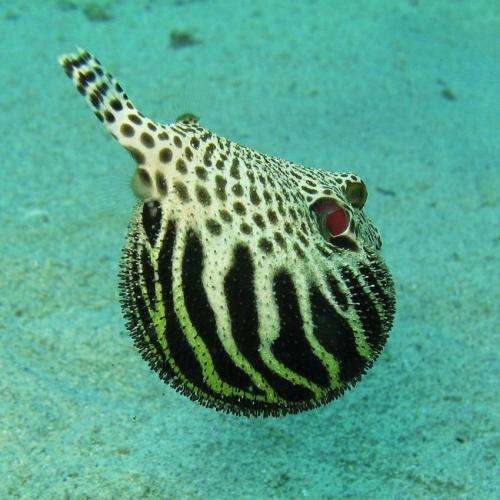Inflated Arothron. Credit: Mactan Cebu, Philippines Arothron stellatus
A pair of researchers, one with James Cook University the other the Australian Institute of Marine Science has shown that the common myth that pufferfish don't breathe when puffed up, is completely wrong. In their paper published in the journal Biology Letters, marine scientists Georgia McGee and Timothy Clark describe their study of the quirky fish and how they disproved the myth.
To uncover the truth, the two researchers ventured out to the Great Barrier Reef and captured several black-saddled pufferfish. The specimens were taken to a lab for testing, which consisted of two tests, both of which involved studying the fish in its puffed up state (by poking them gently with a small sucking tube). The first experiment involved continually measuring oxygen levels in the tanks that housed the fish. The research duo noted that oxygen levels dropped the entire time the fish were in the tanks, including while puffed up. The next experiment was less technical, they simply watched carefully to see if the fish kept their gills closed, a sign that they were not breathing. They found that the fish continued to use their gills while puffed. The two experiments prove, the researchers claim, that pufferfish do not hold their breath when they puff themselves up and actually increase their breathing rate to allow for the exertion involved in the process.
The researchers set themselves the task of conducting the experiments because it came to light that until now, no one had questioned the quasi science that had gone into suggesting the fish held their breath in the first place. Some had theorized that they breathe a little bit through their skin when puffed, to keep themselves alive. The researchers found no evidence of such breathing, which led them to conclude that the fish did in fact continue to breathe when puffed.
The pair found something else that was interesting. Puffing themselves up (filling a bladder with water to intimidate predators) was apparently tiresome—it took over five and half hours for their metabolisms to return to normal after puffing up just one time. They noted also that prior experiments had shown that the process is so tiring that the fish can only do it a few times in a row before growing too exhausted to even give it another try.
More information: All puffed out: do pufferfish hold their breath while inflated? Biology Letters, rsbl.royalsocietypublishing.or … ntent/10/12/20140823
ABSTRACT
The inflation response of pufferfishes is one of the most iconic predator defence strategies in nature. Current dogma suggests that pufferfish inflation represents a breath-holding response, whereby gill oxygen uptake ceases for the duration of inflation and cutaneous respiration increases to compensate. Here, we show that the black-saddled pufferfish (Canthigaster valentini) has an excellent capacity for oxygen uptake while inflated, with uptake rates increasing to five-times that of resting levels. Moreover, we show that this species has negligible capacity for cutaneous respiration, concluding that the gills are the primary site of oxygen uptake while inflated. Despite this, post-deflation recovery of aerobic metabolism took an average of 5.6 h, suggesting a contribution of anaerobic metabolism during pre-inflation activity and during the act of ingesting water to achieve inflation.
Journal information: Biology Letters
© 2014 Phys.org























